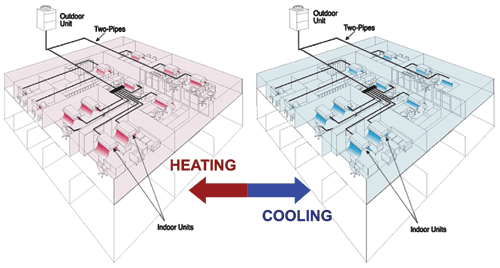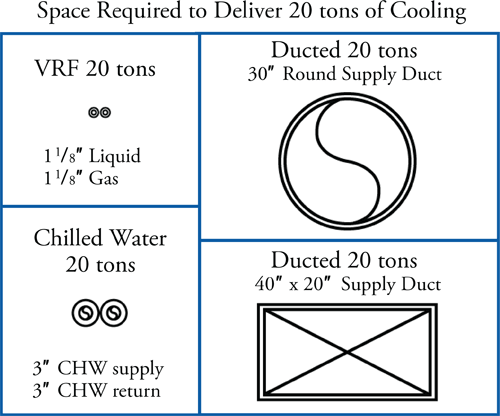Cool VRF Technology
VRF System Advantages
In addition to energy efficiency, VRF systems have many significant advantages. These include integrated controls, quiet operation, design and installation flexibility, compact equipment, lowered lifecycle cost and reduced maintenance costs.
Integrated controls
VRF systems utilize an integrated controls network that links the entire system. The integrated controls network allows all parts of the VRF system to communicate, constantly maximizing efficiency and dialing in the capacity of the system. It also saves data for the purposes of verifyng and measuring long term performance–a necessary feature for obtaining LEED® credit.
A facility manager is able to remotely reset the building's temperature appropriately. If the building is operating in cooling and the outside temperature drops unexpectedly, the facility manager, with a couple of clicks from a remote location, is able to bump up the temperature setpoint, thus saving valuable time and energy.
The controls network can be tied into a standard building management system (BMS). It also may be customized with Internet access. The controls network offers tenant billing which, when combined with watt meters on the exterior, gives the building owner the ability to bill each tenant individually.
Quiet operation
Manufacturers have designed VRF air conditioning systems to operate quietly. Moreover, operating sound levels are greatly reduced because the speed of both the inverter compressor and the condenser fan ramps up and down smoothly when the system's capacity varies. The compressor is surrounded by sound insulation while being housed in its own compartment. These features are especially relevant for libraries, places of worship, lecture halls, classrooms, hospitality spaces and theaters.
 |
Heat pumps can both cool and heat. Image courtesy of Mitsubishi Electric |
Sound pressure levels on one indoor evaporator unit range from 19 dB(A) at low speed (decibel A-weighting takes into consideration the human ear's sensitivity to certain frequencies) to 49 dB(A) at high speed; on another indoor unit, sound pressure levels range from 22 dB(A) at low speed to 47 dB(A) at high speed. Standard indoor equipment sound levels are generally between 45 and 55 dB(A). The sound of indoor units is generally on a par with a recording studio or library.
Outdoor compressor units are also quiet, operating from 50 dB(A) for one small capacity model to about 65 dB(A) for a larger modular unit–no louder than a typical conversation. A typical commercial application of a VRF system has sound levels as low as 61 dB(A). Special care is taken in the design of the outdoor units so that sound is reduced at the source. Specially designed blades and multi-speed motors also reduce system operation sound. The low sound levels allow these outdoor compressor units to be installed near windows, on balconies or near rooftop amenities, giving back usable space and minimizing disruption to the environment.
The great variety of indoor unit styles gives design professionals greater flexibility in deciding on the style, from wall mounted to ceiling concealed, to further minimize any unwanted sound.
Design flexibility
VRF systems offer design, installation and location flexibility.
 |
Plenum space can be reduced by running smaller pipes for VRF systems. Image courtesy of Mitsubishi Electric |
Space saving. Compact inverter compressors and smaller VRF system components, can be installed in smaller spaces both indoors and out, thus freeing up spaces for other uses.
In many buildings, the plenum space requirements are dictated by the mechanical equipment. Since copper refrigerant piping is smaller and lighter than ductwork or steel water pipes used in conventional systems, plenum space can be given back in the form of higher ceiling heights. If enough space is saved on enough floors throughout the building, space can be given back in the form of an additional floor, without the need to increase the overall building height. Smaller sized piping and ductwork are also advantageous when specified for existing buildings.
VRF systems also need less piping and duct space. Compared with chilled water systems VRF systems require smaller amounts of piping to connect the outdoor unit to the indoor units (see figure comparing water piping and ductwork required for VRF and chilled water systems).
With its compact-sized components and small-sized copper piping VRF systems are particularly suitable for adaptive reuse and historic renovation.
Another way that VRF gives back space is by reducing the need for mechanical rooms. Chilled water systems require mechanical rooms to house pumps, chillers, heat exchangers and other equipment that are needed for the chilled water system to function properly. All these systems require space and are additional weight on the structure. VRF reduces the need for all this supporting equipment and gives it back to the owner.
With mechanical equipment taking up less space, there can be more usable interior space. Moreover, more consideration can be given for providing spaces for green roofs, thus further reducing the footprint's impact on the project
Location and installation flexibility. The modular nature of VRF allows considerable flexibility regarding the location of the outdoor unit. It can be mounted either above or below the indoor units within the limitations of the piping lengths, which, depending upon the manufacturer can measure up to 2,624 feet and 3,280 one way. Many VRF systems use T-branches and headers, which add to placement flexibility. Installation generally includes simple two-pipe systems with easy, non-polar, two-wire control connections. This translates into less labor and fewer materials as well as quicker and easier installation.
Total installation costs for VRF may also be smaller, depending on the size of the system–fewer components mean less time spent on installation, and lengths of small-diameter refrigerant piping are easier to install than lengths of ductwork.
Outdoor units (heat recovery, heat pumps) offer vertical air discharge that allows units to be installed side-by-side in a single area, saving space and resources.
 |
Comparison of pipe or duct required to deliver 20 tons of cooling for VRF versus chilled water systems. VRF uses (2) 1-1/8-in. with 1/2-in. insulation, a total of 2-1/8-in. diameter per pipe. Chilled water uses (2) 3-in. with 1-1/2-in. insulation for a total of 6-in. diameter per duct. Ductwork can be up to 30-in. round. Image courtesy of Mitsubishi Electric |









